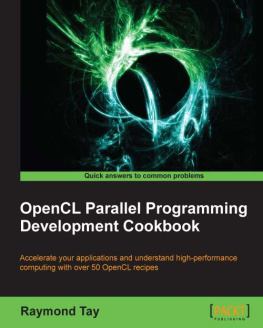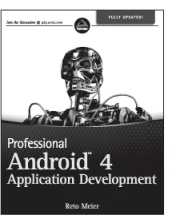David B. Kirk
Wen-mei W. Hwu
Copyright
Acquiring Editor: Todd Green
Editorial Project Manager: Nathaniel McFadden
Project Manager: Priya Kumaraguruparan
Designer: Alan Studholme
Morgan Kaufmann is an imprint of Elsevier
225 Wyman Street, Waltham, MA, 02451, USA
2013, 2010 David B. Kirk/NVIDIA Corporation and Wen-mei Hwu. Published by Elsevier Inc. All rights reserved.
No part of this publication may be reproduced or transmitted in any form or by any means, electronic or mechanical, including photocopying, recording, or any information storage and retrieval system, without permission in writing from the publisher. Details on how to seek permission, further information about the Publishers permissions policies and our arrangements with organizations such as the Copyright Clearance Center and the Copyright Licensing Agency, can be found at our website: www.elsevier.com/permissions.
This book and the individual contributions contained in it are protected under copyright by the Publisher (other than as may be noted herein).
Notices
Knowledge and best practice in this field are constantly changing. As new research and experience broaden our understanding, changes in research methods or professional practices, may become necessary. Practitioners and researchers must always rely on their own experience and knowledge in evaluating and using any information or methods described herein. In using such information or methods they should be mindful of their own safety and the safety of others, including parties for whom they have a professional responsibility.
To the fullest extent of the law, neither the Publisher nor the authors, contributors, or editors, assume any liability for any injury and/or damage to persons or property as a matter of products liability,negligence or otherwise, or from any use or operation of any methods, products, instructions, or ideas contained in the material herein.
Library of Congress Cataloging-in-Publication Data
Application submitted
British Library Cataloguing-in-Publication Data
A catalogue record for this book is available from the British Library.
ISBN: 978-0-12-415992-1
Printed in the United States of America
13 14 15 16 17 10 9 8 7 6 5 4 3 2 1

For information on all MK publications visit our website at www.mkp.com
Preface
We are proud to introduce the second edition of Programming Massively Parallel Processors: A Hands-on Approach. Mass-market computing systems that combine multicore computer processing units (CPUs) and many-thread GPUs have brought terascale computing to laptops and petascale computing to clusters. Armed with such computing power, we are at the dawn of pervasive use of computational experiments for science, engineering, health, and business disciplines. Many will be able to achieve breakthroughs in their disciplines using computational experiments that are of an unprecedented level of scale, accuracy, controllability, and observability. This book provides a critical ingredient for the vision: teaching parallel programming to millions of graduate and undergraduate students so that computational thinking and parallel programming skills will be as pervasive as calculus.
Since the first edition came out in 2010, we have received numerous comments from our readers and instructors. Many told us about the existing features they value. Others gave us ideas about how we should expand its contents to make the book even more valuable. Furthermore, the hardware and software technology for heterogeneous parallel computing has advanced tremendously. In the hardware arena, two more generations of graphics processing unit (GPU) computing architectures, Fermi and Kepler, have been introduced since the first edition. In the software domain, CUDA 4.0 and CUDA 5.0 have allowed programmers to access the new hardware features of Fermi and Kepler. Accordingly, we added eight new chapters and completely rewrote five existing chapters.
Broadly speaking, we aim for three major improvements in the second edition while preserving the most valued features of the first edition. The first improvement is to introduce parallel programming in a more systematic way. This is done by (1) adding new . These additions are designed to remove the assumption that students are already familiar with basic parallel programming concepts. They also help to address the desire for more examples by our readers.
The second improvement is to cover practical techniques for using joint MPI-CUDA programming in a heterogeneous computing cluster. This has been a frequently requested addition by our readers. Due to the cost-effectiveness and high throughput per watt of GPUs, many high-performance computing systems now provision GPUs in each node. The new explains the conceptual framework behind the programming interfaces of these systems.
The third improvement is an introduction of new parallel programming interfaces and tools that can significantly improve the productivity of data-parallel programming. The new introduce OpenACC, Thrust, CUDA FORTRAN, and C++AMP. Instead of replicating the detailed descriptions of these tools from their user guides, we focus on the conceptual understanding of the programming problems that these tools are designed to solve.
While we made all these improvements, we also preserved the first edition features that seem to contribute to its popularity. First, we kept the book as concise as possible. While it is very tempting to keep adding material, we want to minimize the number of pages readers need to go through to learn all the key concepts. Second, we kept our explanations as intuitive as possible. While it is extremely tempting to formalize some of the concepts, especially when we cover the basic parallel algorithms, we strive to keep all our explanations intuitive and practical.
Target Audience
The target audience of this book is graduate and undergraduate students from all science and engineering disciplines where computational thinking and parallel programming skills are needed to achieve breakthroughs. We assume that readers have at least some basic C programming experience. We especially target computational scientists in fields such as mechanical engineering, civil engineering, electrical engineering, bio-engineering, physics, chemistry, astronomy, and geography, who use computation to further their field of research. As such, these scientists are both experts in their domain as well as programmers. The book takes the approach of building on basic C programming skills, to teach parallel programming in C. We use CUDA C, a parallel programming environment that is supported on NVIDIA GPUs and emulated on CPUs. There are more than 375 million of these processors in the hands of consumers and professionals, and more than 120,000 programmers actively using CUDA. The applications that you develop as part of the learning experience will be able to run by a very large user community.








